Study on the Influence of Mandrel Speed on the Titanium Tube Continuous Retained-Mandrel Rolling Process
Abstract
1. Introduction
2. Numerical Modeling of CRR Process
- (1)
- Geometric model properties: The tube blank is set as a plastic body, and the roll and mandrel are considered to be rigid materials that only conduct heat due to their small elastic deformation.
- (2)
- Boundary conditions: Due to the symmetry in the rolling process, only one-sixth of the model was simulated to improve computational efficiency. Symmetry constraints were applied at the symmetrical cross-section of the tube.
- (3)
- Friction conditions: Coulomb friction was selected as the friction model for the rolling simulation, with the friction coefficient assumed to remain constant during the CRR process. The friction coefficient between the rollers and the tube was set to 0.45, while the mandrel, lubricated with a water-based graphite lubricant before rolling, had a friction coefficient of 0.1 [16,17].
- (4)
- Heat transfer conditions: At an ambient temperature of 20 °C, the contact heat transfer coefficient between the tube and the rollers/mandrel was set to 30 kW/m2K. The heat convection coefficient between the tube and the air was 0.02 kW/m2K. The heat transfer coefficients due to frictional deformation and plastic deformation were set to 0.7 and 0.9, respectively [18,19].
3. CRR Experiments
4. Results and Discussion
4.1. Mesh Deformation
4.2. Cross-Shear Zone
4.3. Strain Distribution
4.4. Force–Energy Parameters
4.5. Macroscopic Observation of Shear Deformation
4.6. Microstructure
5. Conclusions
- Under different mandrel diameter coefficients, the mandrel speed has a similar impact on the deformation state of the tube. During rapid mandrel rolling, the shear strain concentrates in the inner and outer layers of the tube, with the inner wall primarily undergoing compressive deformation. As the mandrel speed decreases, the shear strain becomes uniformly distributed in the thickness direction of the tube, allowing shear deformation to penetrate better into the inner wall. At a mandrel diameter coefficient of 0.3, the shear strain at the inner wall can reach 0.63.
- As the mandrel speed decreases, the shear strain at the groove vertex first continuously increases and then decreases to a stable value, reaching a maximum at a speed of 240 mm/s. The increase in shear strain is mainly due to the enlargement of the rolling zone, while the subsequent decrease is attributed to the reduction in rolling force, which diminishes the friction between the roll and the outer surface of the tube, thereby weakening the rolling effect. Furthermore, the shear strain cannot continue to decrease due to limitations in the rolling zone area.
- A macroscopic shear-deformation observation experiment was designed in the tube for the first time. During slow mandrel rolling, the shear angle of the implanted material was 58.5°, uniformly distributed in the thickness direction, which is close to the numerical simulation result of 56.3°.
- As the mandrel speed decreases, the microstructure at the groove vertex of the titanium tube becomes more uniform in the thickness direction. The generated and twins gradually disappear, indicating that the main deformation mechanism shifts from twinning to dislocation slip. The volume fraction of recrystallization gradually increases from 18.4% to 42.3%.
Author Contributions
Funding
Data Availability Statement
Conflicts of Interest
References
- Wang, C.P.; Wang, H.Z.; Ruan, G.L.; Wang, S.H.; Xiao, Y.X.; Jiang, L.D. Applications and prospects of titanium and its alloys in seawater desalination industry. IOP Conf. Ser. Mater. Sci. Eng. 2019, 688, 033036. [Google Scholar] [CrossRef]
- Gorynin, I.V.; Oryshchenko, A.S.; Leonov, V.P.; Mikhailov, V.I.; Schastlivaia, I.A. Titanium Application in Marine Engineering and Nuclear-Power Engineering. In Proceedings of the 13th World Conference on Titanium; John Wiley & Sons, Inc.: Hoboken, NJ, USA, 2016. [Google Scholar]
- Schutz, R.W.; Watkins, H.B. Recent developments in titanium alloy application in the energy industry. Mater. Sci. Eng. A 1998, 243, 305–315. [Google Scholar] [CrossRef]
- Chao, Q.; Sabirov, I.; Guo, T.; Hodgson, P.D.; Beladi, H. Tailoring the deformation characteristics of commercial purity titanium through hot deformation of a martensitic microstructure. Mater. Sci. Eng. A 2021, 827, 142075. [Google Scholar] [CrossRef]
- Oryshchenko, A.; Leonov, V.; Mikhailov, V.; Kuznetsov, P.; Alexandrov, A. Titanium in shipbuilding and other technical applications. MATEC Web Conf. 2020, 321, 02001. [Google Scholar] [CrossRef]
- Song, D.J.; Niu, L.; Yang, S.L. Research on Application Technology of Titanium Alloy in Marine Pipeline. Rare Met. Mater. Eng. 2020, 49, 1100–11040. [Google Scholar]
- Titanium Information Group. Titanium for Offshore and Marine Applications: A Designers and Users Handbook; National Metals Technology Centre Ltd.: Rotherham, UK, 2006. [Google Scholar]
- Wang, C.F.; Xue, J.G.; Zhou, Z.Y.; Ji, B.; Wu, Y.Y.; Zhang, C.X.; Sun, H.M. A preliminary discussion on Making Ti-alloy OCTG by using the floationg-Mandril method. Non-Ferr. Min. Metall. 2015, 31, 34–36. [Google Scholar]
- Li, X.W.; Dong, B. Finite element analysis of temperature field of PQF mandrel. Baosteel Technol. 2016, 54–59. [Google Scholar] [CrossRef]
- Pang, N.; Zhan, Z.Y. Simulation of Stress Field During Φ159 mm FQM Mandrel Service Process. Hot Work. Technol. 2015, 44, 138–141. [Google Scholar]
- Chernykh, I.N.; Shendyapin, K.V.; Game, E.A. Studying the Effect of the Mandrel Diameter on the Quality of Pipes Produced by Longitudinal Rolling. Metallurgist 2021, 65, 147–152. [Google Scholar] [CrossRef]
- Li, C.; Yuanhua, S.; Chen, J.; Zhou, Y.; Dong, B.; Wang, C.; Chen, C.; Yujun, G. Research on the impact of mandrels in titanium tubes during tube continuous rolling. Mater. Res. Express 2023, 10, 086512. [Google Scholar] [CrossRef]
- Lan, X.C.; Liu, H.M. Effect of mandrel moving speed and mandrel friction on continuous seamless-tube rolling process. Iron Steel 1994, 29, 28–33. [Google Scholar]
- Zhou, Z.P. Finite Element Analysis of Effect on Pierced Billet Dimensional Accuracy by Retained Mandrel Speed of MPM Pipe Mill. Steel Pipe 2020, 49, 4. [Google Scholar]
- Yin, Y.D.; Li, S.Z. 3D finite element analysis of effect of mandrel on continuous seamless tube rolling process. Heavy Mach. 2005, 1, 40–43. [Google Scholar]
- Takahashi, K.; Inoue, T.; Uchida, S. Characteristics of hot friction in commercially pure titanium. Nippon. Steel Tech. Rep. Overseas 2002, 85, 41–46. [Google Scholar]
- Wang, H.; Xu, B.; Liu, J. Micro and Nano Sulfide Solid Lubrication; Springer: Berlin/Heidelberg, Germany, 2012. [Google Scholar]
- Nemat-Nasser, S.; Guo, W.-G.; Nesterenko, V.F.; Indrakanti, S.; Gu, Y.-B. Dynamic response of conventional and hot isostatically pressed Ti–6Al–4V alloys: Experiments and modeling. Mech. Mater. 2001, 33, 425–439. [Google Scholar] [CrossRef]
- Yoshida, M. 3D FEM simulation of rolling load working on piercer plug in mannesmann piercing process. AIP Conf. Proc. 2010, 1252, 1333–1338. [Google Scholar]
- Thota, M.K.; Kapoor, R.; Basak, C.B.; Mukherjee, A.B.; Chakravartty, J.K. High temperature deformation of α-Ti. Mater. Sci. Eng. A 2015, 624, 213–219. [Google Scholar] [CrossRef]
- Dhinwal, S.S.; Toth, L.S.; Lapovok, R.; Hodgson, P.D. Tailoring one-pass asymmetric rolling of extra low carbon steel for shear texture and recrystallization. Materials 2019, 12, 1935. [Google Scholar] [CrossRef]
- Tang, D.L.; Liu, X.H. Geometric parameters in cross shear zone of asymmetrical rolling. Iron Steel 2015, 50, 34–39. [Google Scholar] [CrossRef]
- Dobatkin, S.; Galkin, S.; Estrin, Y.; Serebryany, V.; Diez, M.; Martynenko, N.; Lukyanova, E.; Perezhogin, V. Grain refinement, texture, and mechanical properties of a magnesium alloy after radial-shear rolling. J. Alloys Compd. 2019, 774, 969–979. [Google Scholar] [CrossRef]
- Wang, L.; Fan, X.G.; Zhan, M.; Jiang, X.Q.; Liang, Y.F.; Zheng, H.J.; Liang, W.J. Revisiting the lamellar globularization behavior of a two-phase titanium alloy from the perspective of deformation modes. J. Mater. Process. Technol. 2021, 289, 116963. [Google Scholar] [CrossRef]
- Serajzadeh, S.; Taheri, A.K.; Nejati, M.; Izadi, J.; Fattahi, M. An investigation on strain inhomogeneity in hot strip rolling process. J. Mater. Process. Technol. 2002, 128, 88–99. [Google Scholar] [CrossRef]
- Kim, K.H.; Lee, D.N. Analysis of deformation textures of asymmetrically rolled aluminum sheets. Acta Mater. 2001, 49, 2583–2595. [Google Scholar] [CrossRef]
- Kim, S.H.; You, B.S.; Yim, C.D.; Seo, Y.M. Texture and microstructure changes in asymmetrically hot rolled AZ31 magnesium alloy sheets. Mater. Lett. 2005, 59, 3876–3880. [Google Scholar] [CrossRef]
- Chen, X.; Tang, B.; Liu, D.; Wei, B.; Zhu, L.; Liu, R.; Kou, H.; Li, J. Dynamic recrystallization and hot processing map of Ti-48Al-2Cr-2Nb alloy during the hot deformation. Mater. Charact. 2021, 179, 111332. [Google Scholar]
- Zeng, Z.; Jonsson, S.; Roven, H.J. The effects of deformation conditions on microstructure and texture of commercially pure Ti. Acta Mater. 2009, 57, 5822–5833. [Google Scholar]

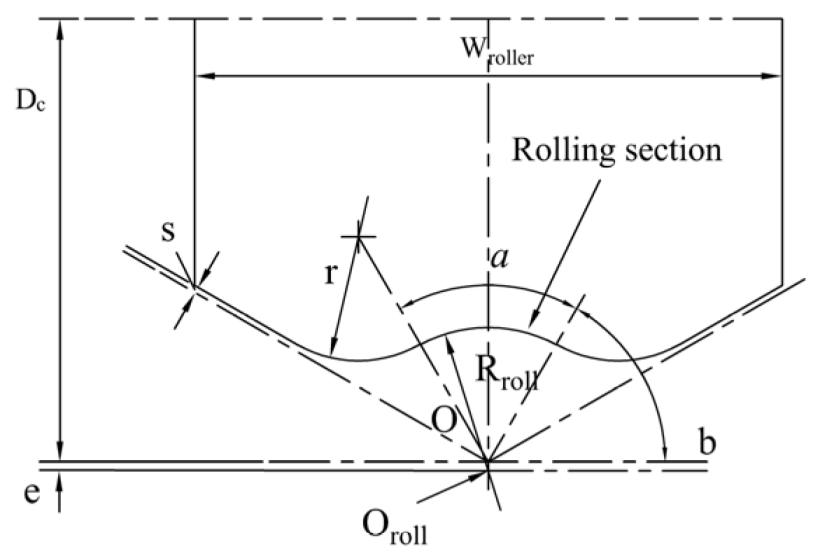
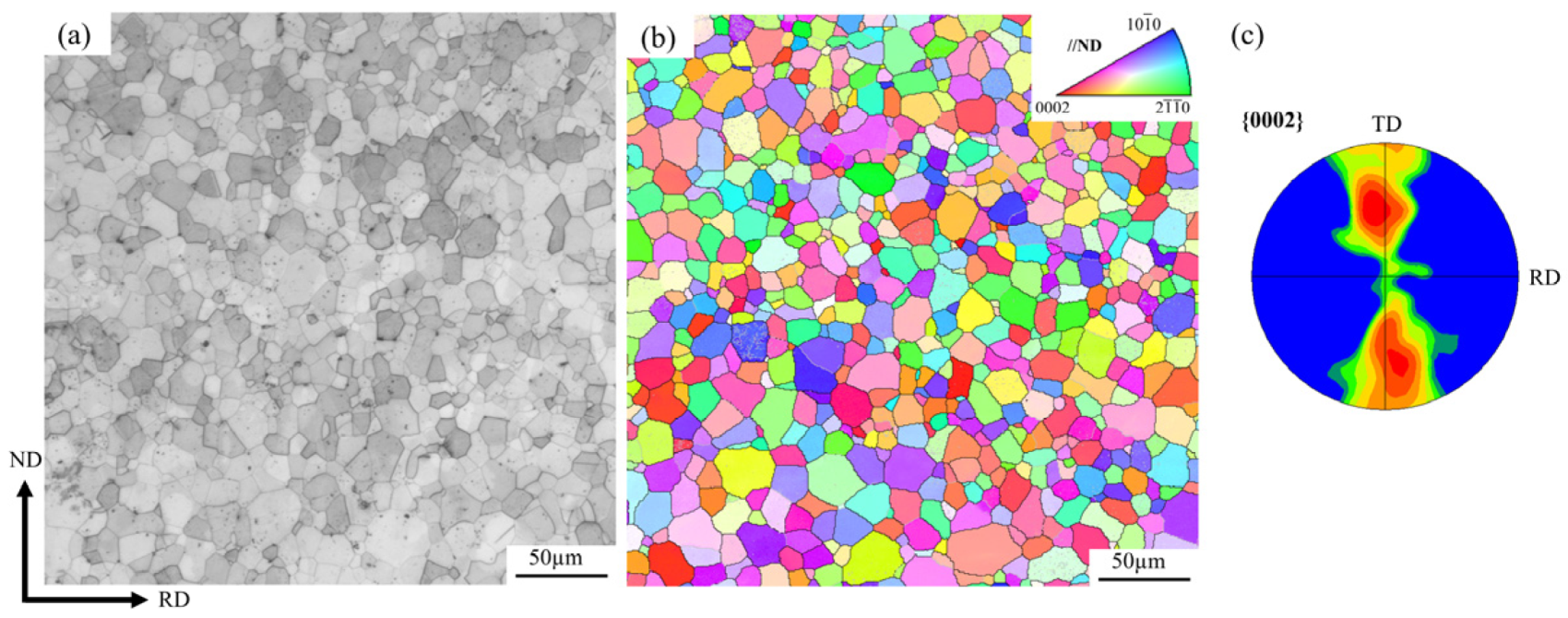
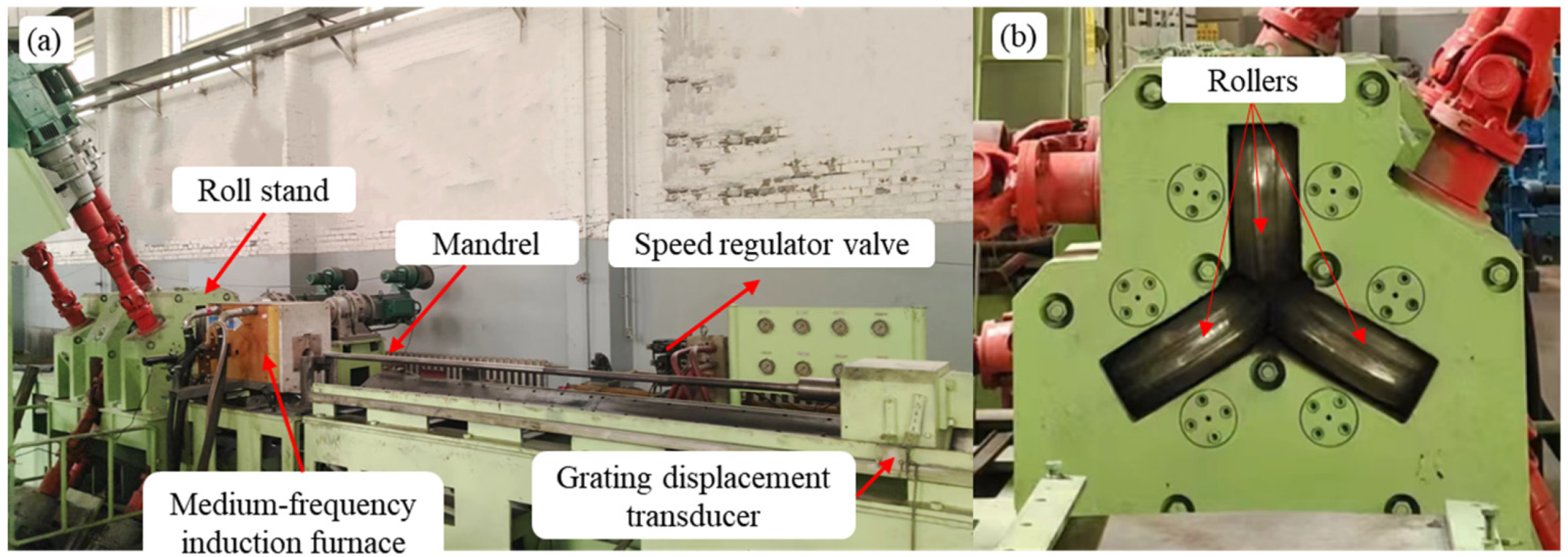

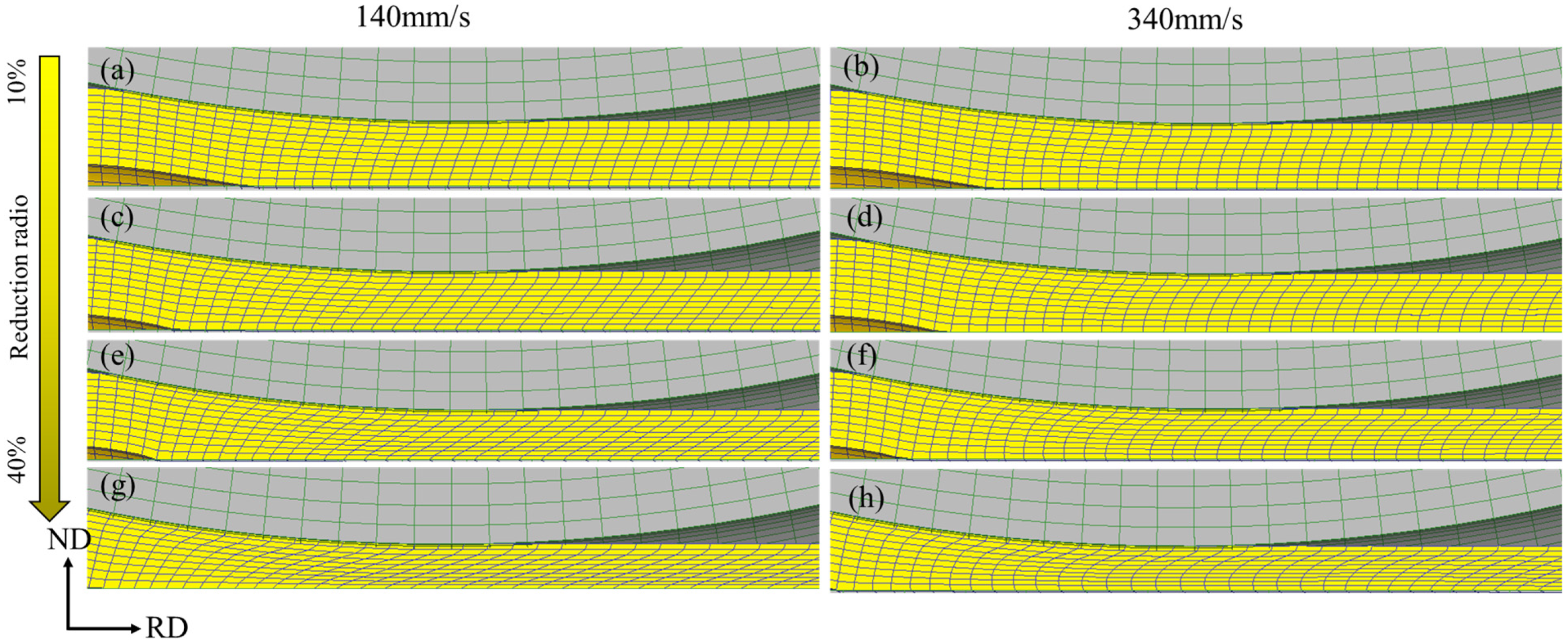




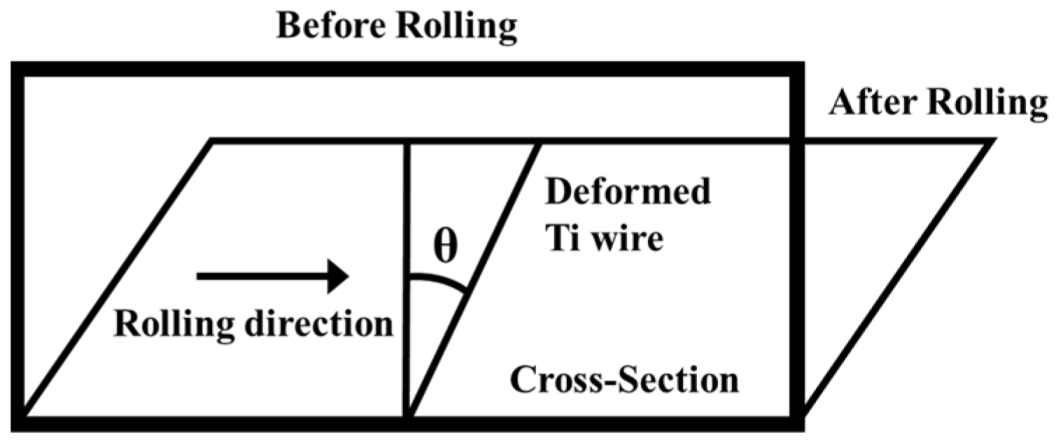

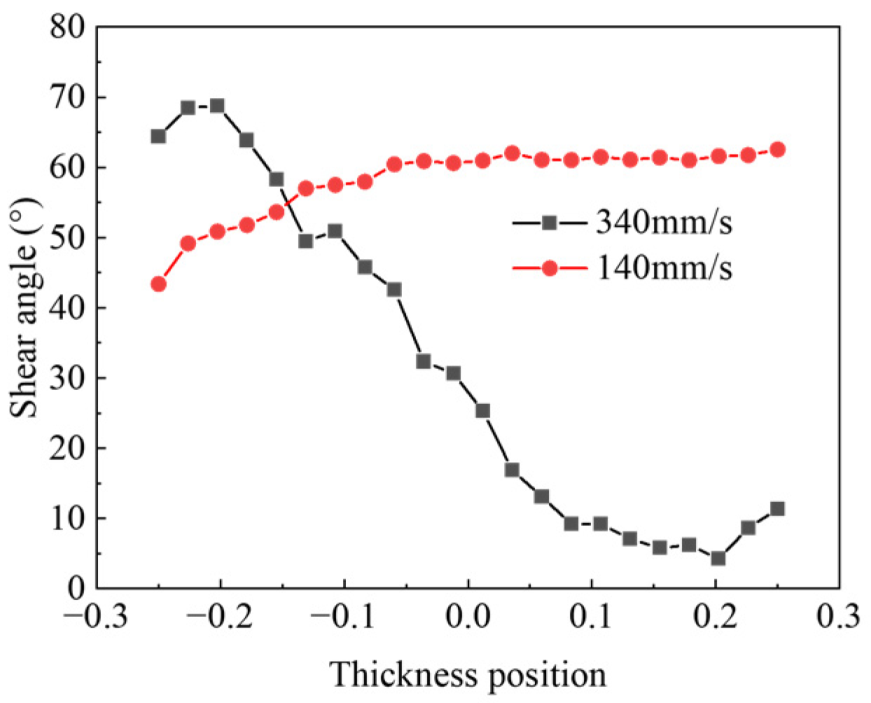
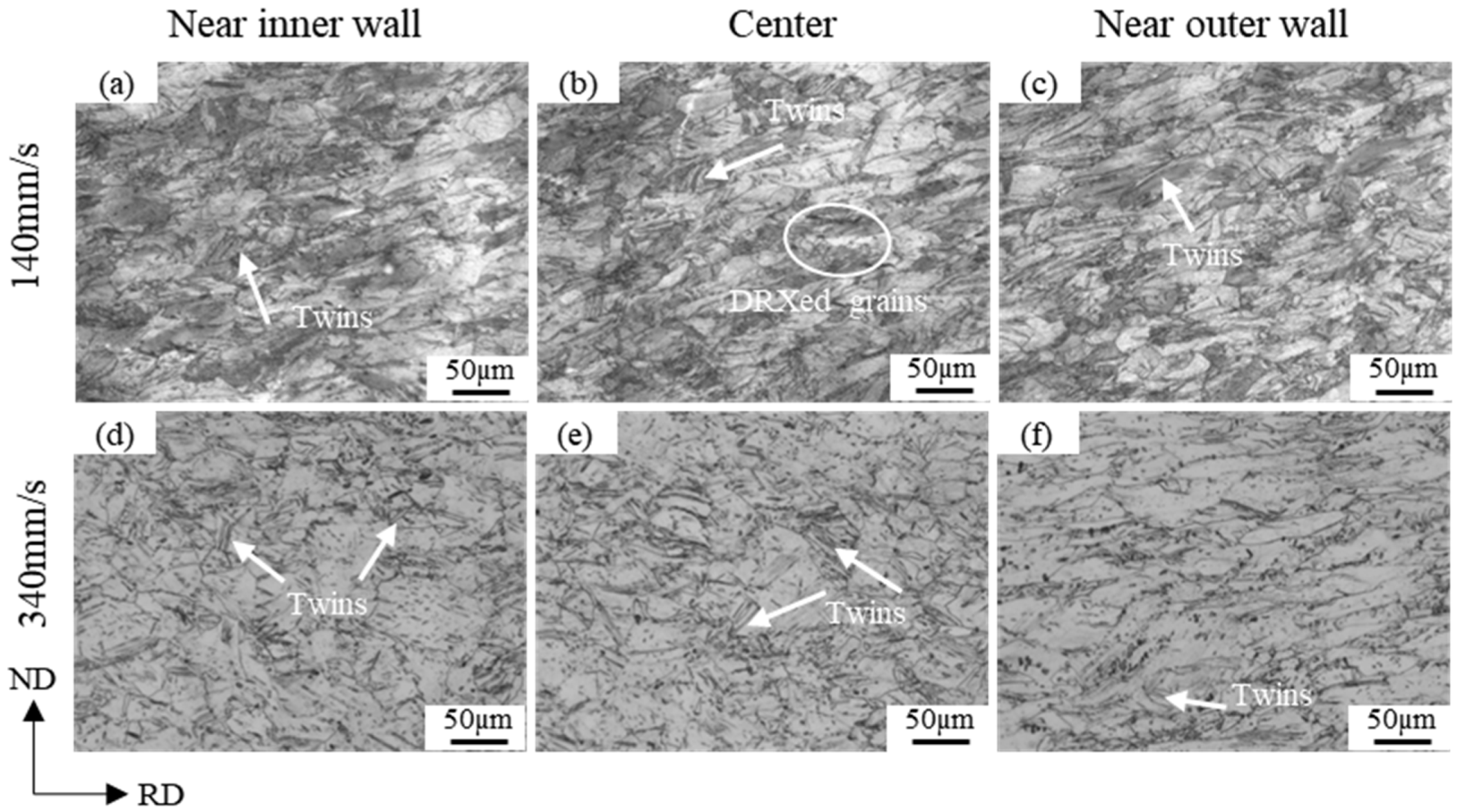
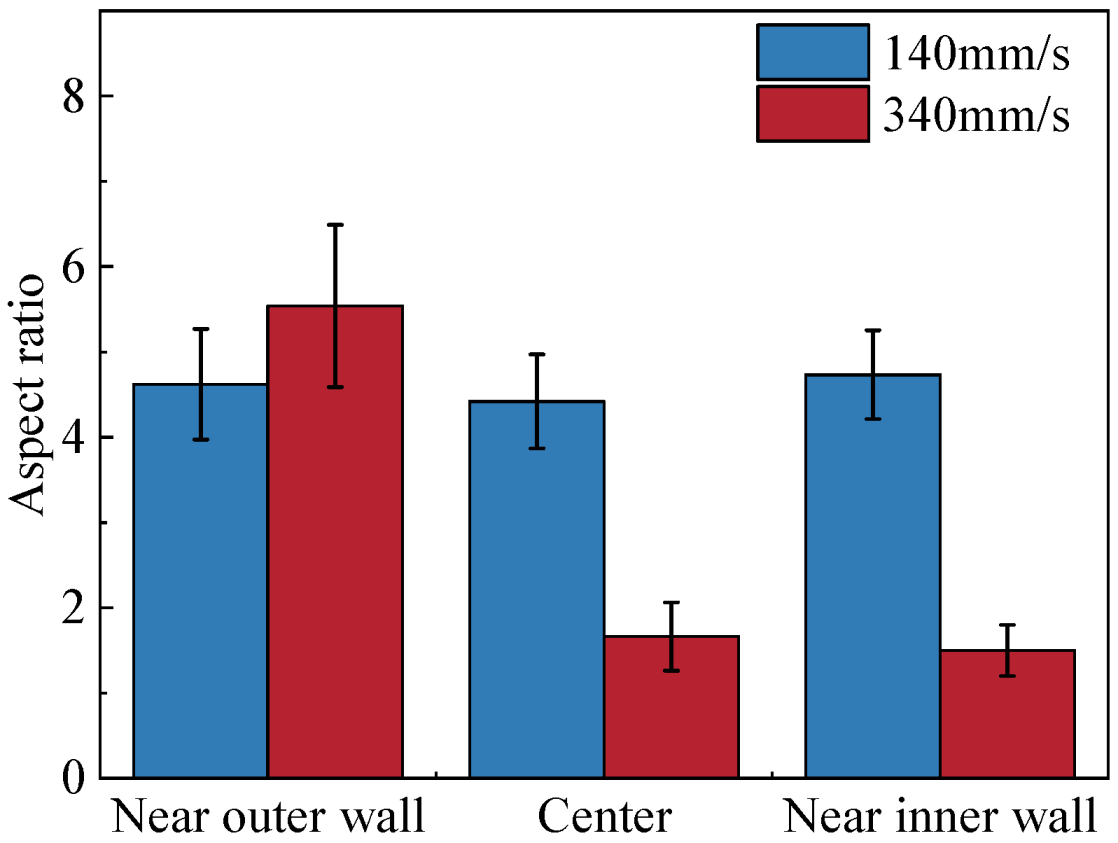
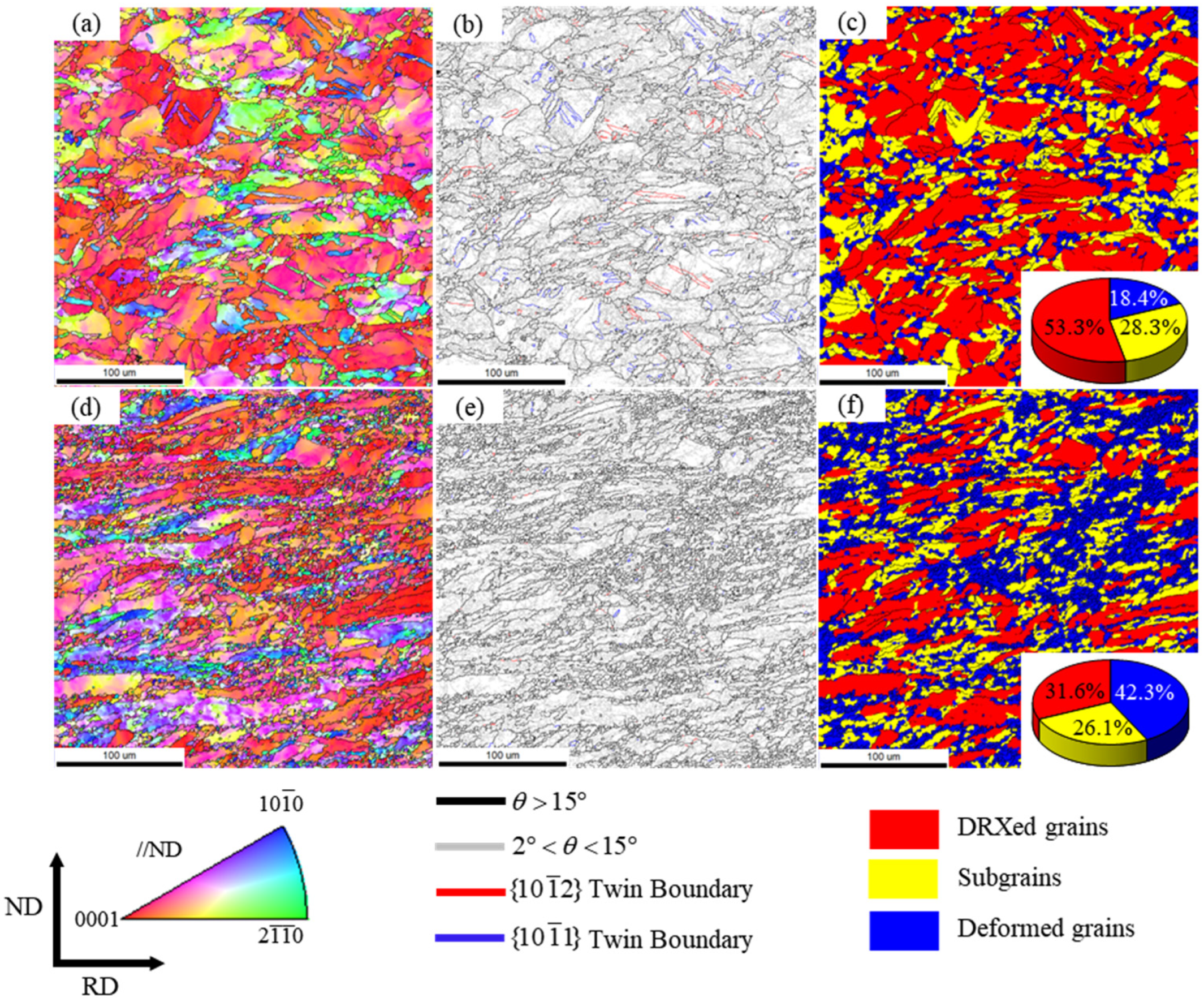
| Code | Introduction | 1#pass | 2#pass | 3#pass |
|---|---|---|---|---|
| a | Rolling section angle (deg) | 60 | ||
| b | Angle (deg) | 60 | ||
| Wroller | Roller width (mm) | 100 | ||
| O | Rolling center | |||
| Oroll | The center of the rolling section | |||
| Dc | Distance between the roller centerline and the rolling centerline (mm) | 170 | ||
| s | Distance of the gap between a roller and its adjacent roller (mm) | 1 | ||
| e | Distance between point O and Oroll (mm) | 1.5 | 0 | 0 |
| r | Roller gap radius (mm) | 21.09 | 20.00 | 20.00 |
| Rroll | Rolling radius (mm) | 24.40 | 22.00 | 22.00 |
| nroll | Roller rotational velocity (rpm) | 21.33 | ||
| T | Initial temperature of workpiece (°C) | 750 | ||
Disclaimer/Publisher’s Note: The statements, opinions and data contained in all publications are solely those of the individual author(s) and contributor(s) and not of MDPI and/or the editor(s). MDPI and/or the editor(s) disclaim responsibility for any injury to people or property resulting from any ideas, methods, instructions or products referred to in the content. |
© 2024 by the authors. Licensee MDPI, Basel, Switzerland. This article is an open access article distributed under the terms and conditions of the Creative Commons Attribution (CC BY) license (https://creativecommons.org/licenses/by/4.0/).
Share and Cite
Li, C.; Shuang, Y.; Chen, J.; Wu, T. Study on the Influence of Mandrel Speed on the Titanium Tube Continuous Retained-Mandrel Rolling Process. Metals 2024, 14, 1024. https://doi.org/10.3390/met14091024
Li C, Shuang Y, Chen J, Wu T. Study on the Influence of Mandrel Speed on the Titanium Tube Continuous Retained-Mandrel Rolling Process. Metals. 2024; 14(9):1024. https://doi.org/10.3390/met14091024
Chicago/Turabian StyleLi, Chao, Yuanhua Shuang, Jianxun Chen, and Tao Wu. 2024. "Study on the Influence of Mandrel Speed on the Titanium Tube Continuous Retained-Mandrel Rolling Process" Metals 14, no. 9: 1024. https://doi.org/10.3390/met14091024
APA StyleLi, C., Shuang, Y., Chen, J., & Wu, T. (2024). Study on the Influence of Mandrel Speed on the Titanium Tube Continuous Retained-Mandrel Rolling Process. Metals, 14(9), 1024. https://doi.org/10.3390/met14091024






